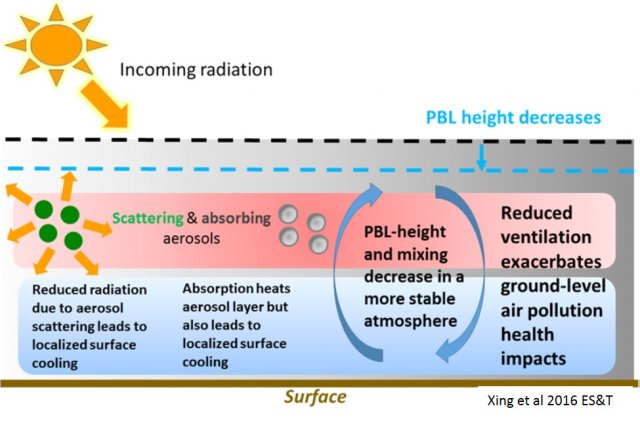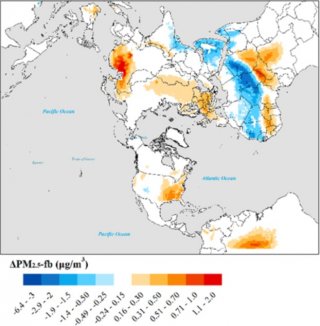WRF-CMAQ Model
Overview
Air quality models are typically run in two different ways:
- Standalone – Archived output from a meteorological model is used to drive the air quality model.
- Coupled – The air quality and meteorological models are run simultaneously and the chemistry can impact the weather.
The latter “coupled” method is beneficial for studying important interactions between chemistry and weather. For example, aerosols can affect the amount of sunlight that reaches the surface, thus impacting temperature. Aerosols also have important impacts on cloud formation and cloud albedo. CMAQ has been coupled to the Weather Research and Forecasting (WRF) model for this purpose.
In the WRF-CMAQ model (Wong et al., 2012), WRF and CMAQ are simultaneously integrated and information from CMAQ, like aerosol concentration, is passed into WRF so that the chemistry can impact the weather. Specifically, the WRF-CMAQ model gives users the options to pass aerosol optical properties to the radiation modules in WRF (aerosol direct radiative effects) and adjust the call frequency of WRF and CMAQ to balance the accuracy of the simulation with computational cost.
Aerosol Direct Radiative Feedback Effects
The presence of aerosols impacts the amount of radiation reaching the surface, in turn altering the energy budget of the atmosphere. This is called the short-wave aerosol direct radiative effect. This has been implemented in the shortwave Rapid Radiative Transfer Model for General Circulation Models (RRTMG) radiation scheme in WRF, where aerosol optical properties such as extinction, single scattering albedo, and asymmetry factor, are calculated for 14 wavelength bands (Clough et al. 2005) using aerosol composition and size information simulated by CMAQ. The implementation utilizes the core-shell model where black carbon is treated as the center and the other substances comprise the shell. The aerosol optics calculations are based on Bohren and Huffman (1983).
Application and Evaluation
The aerosol optics calculations in the WRF-CMAQ model were assessed through comparison to measured optical properties of ambient aerosols made during the Carbonaceous Aerosol and Radiation Effects Study (CARES) as detailed by Gan et al. (2015a).
The ability of the WRF-CMAQ system to reproduce historical trends in the tropospheric aerosol burden, aerosol optical depths, and clear-sky short wave radiation across the northern hemisphere and the U.S., has recently been assessed through extensive comparisons of long-term simulations of these quantities with observation-derived records from 1990 to 2010 (Xing et al. 2015a,b; Gan et al., 2015b). The model captured declining Aerosol Optical Depth (AOD) trends along with the corresponding decreased top-of-atmosphere (TOA) short-wave radiation (SWR), or upwellingThe upward movement of an air mass in the atmosphere., and increased surface SWR, or downwellingThe downwelling movement of an air mass in the atmosphere., in the eastern US, Europe and the northern Atlantic for the period of 2000–2010. Estimates of the aerosol direct radiative effects (ADE) at TOA were comparable with those derived from measurements and, compared to general circulation models, the model exhibited better estimates of surface-aerosol direct radiative efficiency (Eτ) (Xing et al., 2015b).
Additionally, top-of-atmosphere clear-sky shortwave radiation during 2000-2010, inferred from the NASA Cloud and Earth’s Radiant Energy System (CERES) satellite retrievals show decreasing trends in the eastern U.S. and increasing trends in eastern China. The inclusion of ADE in WRF-CMAQ yielded better agreement with these contrasting trends suggesting that the trends in clear-sky radiation are influenced by trends in the tropospheric aerosol burden (Xing et al., 2015; Mathur et al., 2017).
Impacts of aerosol cooling are not limited to changes in surface temperature, since variation in atmospheric dynamics caused by the increased stability can worsen local air quality and impact human health (Xing et al., 2016).
Hemispheric WRF-CMAQ model simulation over two decades (1990−2010) shows enhanced surface PM2.5 concentrations in the most polluted regions of the world due to the aerosol direct effect (Xing et al., 2016).
History and Latest Version
The first WRF-CMAQ system was released in 2012 and used WRFv3.3 and CMAQv5.0. Starting from WRFv4.4 and CMAQv5.3.3, user can construct the coupled model with any version of WRF (v4.4 or later) and any version of CMAQ (v5.3.3 or later). Information on the most current version of the WRF-CMAQ system can be found on the Access CMAQ Source Code page.
References
Bohren, C. F. & Huffman, D. R. (1983). Absorption and Scattering of Light by Small Particles, Wiley-Interscience, New York, USA, 530 pp.
Clough, S.A., Shephard, M. W., Mlawer, E. J., Delamere, J. S., Iacono, M. J., Cady-Pereira, K., Boukabara, S., & Brown, P. D. (2005). Atmospheric radiative transfer modeling: a summary of the AER codes. J. Quant. Spectrosc. Ra., 91, 233–244.
Gan, C., Binkowski, F., Pleim, J., Xing, J., Wong, D-C., Mathur, R., & Gilliam, R. (2015a). Assessment of the Aerosol Optics Component of the Coupled WRF-CMAQ Model using CARES Field Campaign data and a Single Column Model. Atmospheric Environment, 115, 670-682. doi: 10.1016/j.atmosenv.2014.11.028
Gan, C., Pleim, J., Mathur, R., Hogrefe, C., Long, C., Xing, J., Wong, D-C., Gilliam, R., & Wei, C. (2015b). Assessment of long-term WRF–CMAQ simulations for understanding direct aerosol effects on radiation "brightening" in the United States. Atmospheric Chemistry and Physics, 15, 12193-12209. doi: 10.5194/acp-15-12193-2015
Mathur, R., Pleim, J., Wong, D., Otte, T., Gilliam, R., Roselle, S., Young, J. (2011). Overview of the Two-way Coupled WRF-CMAQ Modeling System. 2011 CMAS Conference, Chapel Hill, NC. Presentation available from the CMAS conference website.
Mathur, R., Xing, J., Gilliam, R., Sarwar, G., Hogrefe, C., Pleim, J., Pouliot, G., Roselle, S., Spero, T. L., Wong, D. C., & Young, J. (2017). Extending the Community Multiscale Air Quality (CMAQ) modeling system to hemispheric scales: overview of process considerations and initial applications, Atmos. Chem. Phys., 17, 12449–12474, doi:10.5194/acp-17-12449-2017
Wong, D.C., Pleim, J., Mathur, R., Binkowski, F., Otte, T., Gilliam, R., Pouliot, G., Xiu, A., and Kang, D. (2012). WRF-CMAQ two-way coupled system with aerosol feedback: software development and preliminary results. Geosci. Model Dev., 5, 299-312. doi: 10.5194/gmd-5-299-2012
Xing, J., Mathur, R., Pleim, J., Hogrefe, C., Gan, C.-M., Wong, D. C., & Wei, C. (2015a). Can a coupled meteorology–chemistry model reproduce the historical trend in aerosol direct radiative effects over the Northern Hemisphere?, Atmos. Chem. Phys., 15, 9997–10018, doi: 10.5194/acp-15-9997-2015
Xing, J., Mathur, R., Pleim, J., Hogrefe, C., Gan, C.-M., Wong, D., Wei, C., & Wang, J. (2015b) Air pollution and climate response to aerosol direct radiative effects: a modeling study of decadal rends across the Northern Hemisphere, J. Geophys. Res.-Atmos., 120, 12221–12236, doi: 10.1002/2015JD023933
Xing, J., Wang, J., Mathur, R., Pleim, J., Wang, S., Hogrefe, C., Gan, C.-M., Wong, D., & Hao, J. (2016). Unexpected benefits of reducing aerosol cooling effects, Environ. Sci. Technol., 50, 7527– 7534, doi: 10.1021/acs.est.6b00767



